The Western Digital Black PCIe SSD (512GB) Review
by Billy Tallis on March 8, 2017 8:30 AM ESTMixed Random Read/Write Performance
The mixed random I/O benchmark starts with a pure read test and gradually increases the proportion of writes, finishing with pure writes. The queue depth is 3 for the entire test and each subtest lasts for 3 minutes, for a total test duration of 18 minutes. As with the pure random write test, this test is restricted to a 16GB span of the drive, which is empty save for the 16GB test file.
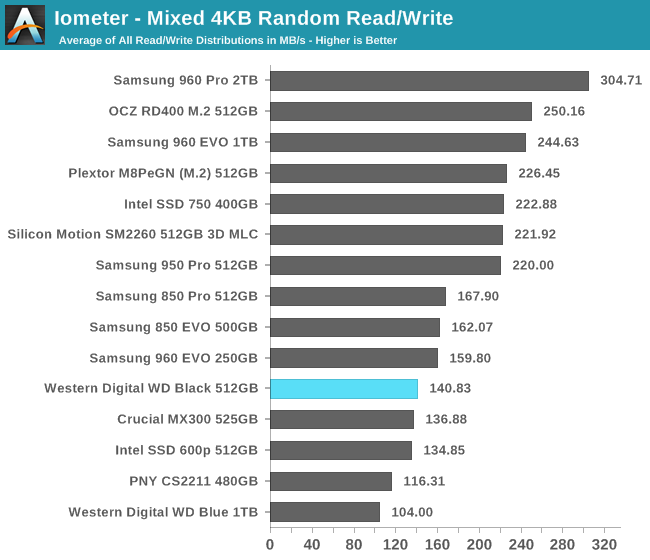
The WD Black's mixed random performance is better than most SATA SSDs and better than the Intel 600p, but both the Samsung 850 EVO and 850 PRO have a clear advantage over the WD Black.
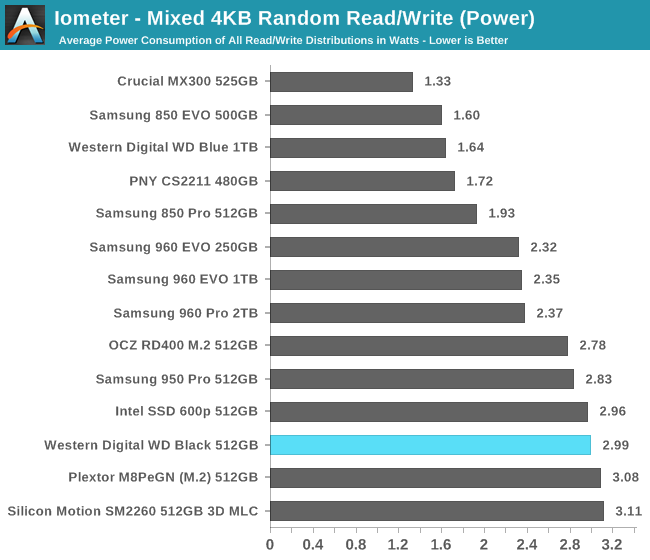
The WD Black's power consumption is a bit high by PCIe standards, but not quite as high as the Plextor M8Pe which uses the same controller. Given the sub-par performance of the WD Black, its efficiency is bad: on par with the Intel 600p, less than half that of the Samsung 850 EVO or Crucial MX300, and far behind that of the Samsung 960 EVO.
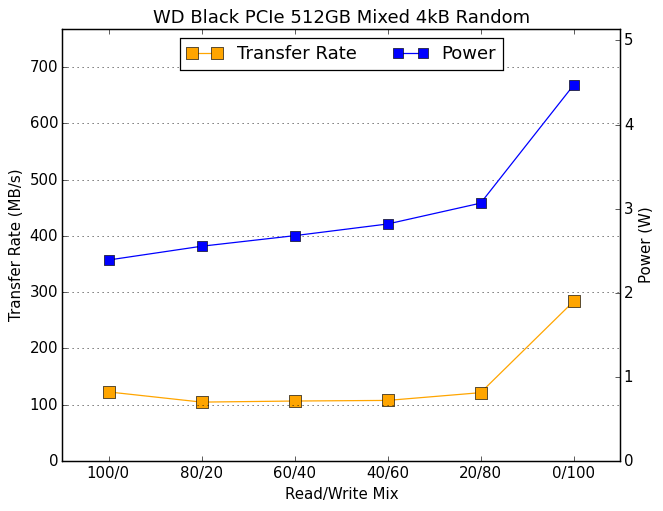 |
|||||||||
The WD Black's performance is pretty flat over the course of the mixed random I/O test, save for the typical jump in the final phase as the workload shifts to pure random writes. The jump isn't high enough to bring the average up above the best SATA SSDs, and the WD Black doesn't show the gradual improvement over the course of the test that the MLC PCIe SSDs experience.
Mixed Sequential Read/Write Performance
The mixed sequential access test covers the entire span of the drive and uses a queue depth of one. It starts with a pure read test and gradually increases the proportion of writes, finishing with pure writes. Each subtest lasts for 3 minutes, for a total test duration of 18 minutes. The drive is filled before the test starts.
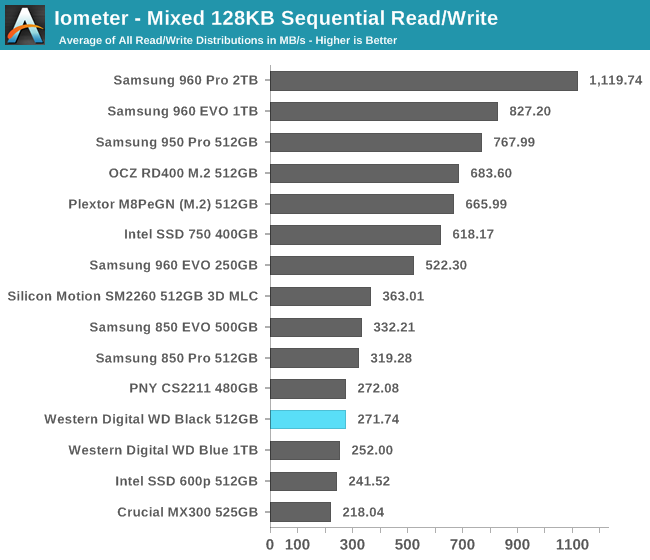
On the mixed sequential I/O test the WD Black performs like a good but not great SATA SSD, with a slight advantage over the WD Blue.
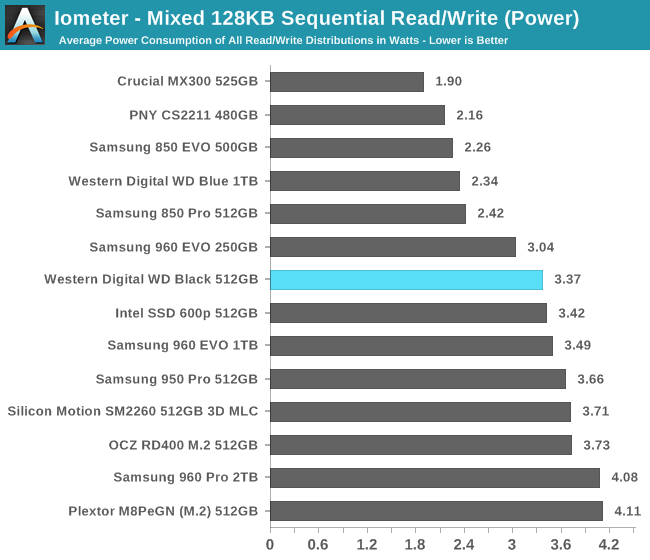
The WD Black's power consumption during this test is on the low side of normal for PCIe SSDs, but its efficiency still isn't remotely competitive with Samsung's 3D TLC.
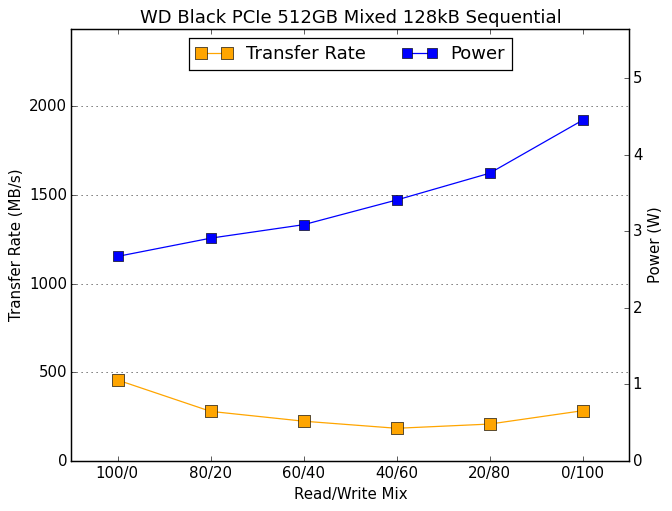 |
|||||||||
The WD Black starts the test with performance near the limit for SATA, but it drops from there as writes are added to the mix. The performance recovers slightly in the final two phases of the test. Power consumption climbs steadily over the course of the test, while most drives manage to reduce power consumption slightly as their performance drops.










36 Comments
View All Comments
jjj - Wednesday, March 8, 2017 - link
At least it beats the Intel lolSuch a pity that SSD makers are messing around with slow options.
As NAND prices rise, the controller becomes a smaller % of the costs so offering great perf per $ is easy, as long as you have the perf and they don't.
I do have a bit of an objection to the way you talk about the 960 EVO in your conclusions.
You haven't tested the 500GB version or at least it's not in the graphs or bench and it's hard to be accurate in estimating its perf due to the SLC cache. A review for it would be nice and maybe the very popular MyDigitalSSD.
Gothmoth - Wednesday, March 8, 2017 - link
slow options are not bad if they would give me 2 TB for 200$... :)but this is just crappy stuff.
jjj - Wednesday, March 8, 2017 - link
Slow options with PCIe x4 drives so these things that offer too little over SATA.They make sense for OEMs in laptop and SFF, lower mechanical volume but the opportunity to make a buck is bigger with faster drives right now.
ImSpartacus - Thursday, March 9, 2017 - link
Yeah, pcie drives busy doubt make sense for the budget market at the moment.It's just an unnecessary cost for a use case that doesn't need the extra benefit. 2.5" sata drives can get too cheap and are too versatile.
theuglyman0war - Sunday, March 12, 2017 - link
Whats everyone complaining about? It's a.... OOPs! Read the that 800MB/s as if that was 800GB size for $199..LOL! nevermind...
Samus - Thursday, March 9, 2017 - link
I'd as clueless as everyone else as to why non-3D TLC is even a thing, especially in a product not limited by SATA.Bruce427 - Monday, March 13, 2017 - link
** A review for it would be nice [on] the very popular MyDigitalSSD. **I agree. I have one of their 480GB BPX models ($187.32) in one of my PCs and I cannot tell much difference between it and the Samsung 512GB 950 Pro.
The MyDigitals are probably the best performing lower priced NVMe drives. They also have a 5 year warranty and huge endurance (TBW) ratings.
ATB - Sunday, April 1, 2018 - link
huge endurance? Looking at 256GB size (80TBW for the WD Black) in the same price range: Intel's 600P is at 144, Kingston's KC1000 is at 300 ant Plextor's M8Pe is at... 384!!! Which means that the life-span of the black is less than 1/4 of the M8Pe's :(Mathieu Bourgie - Wednesday, March 8, 2017 - link
Reading the introduction: 'In the SATA space SanDisk has made very effective use of their planar TLC and the SanDisk X400 and WD Blue are the best in their class. 'Sure, the Sandisk X400 is a leading TLC drive, but how is the WD Blue the best in its class (and what class is that?).
From your own review of the WD Blue SSD: 'Unfortunately, the WD Blue is slower than the X400 on most other tests' and it has a 3 years warranty instead of 5 years for the Sandisk X400.
highlnder69 - Wednesday, March 8, 2017 - link
Not sure who would want to Pre-Order such a horrible performing SSD.